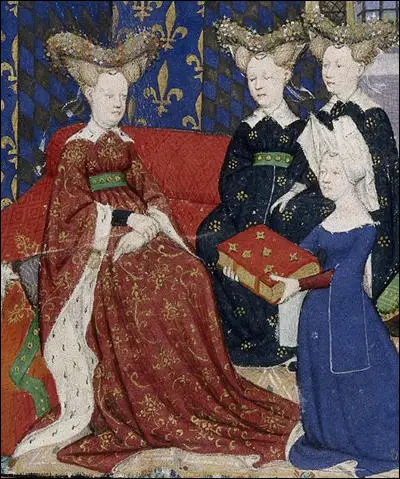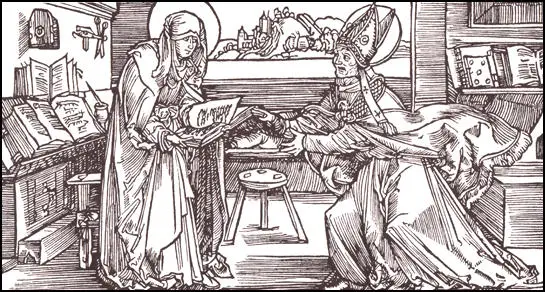Women and Literacy
In the Middle Ages only a small percentage of the population could read or write. Men were more likely to be literate than women. The main reason for this was that women were usually denied an education. Even in wealthy families, it was often considered wrong to spend time and money on teaching daughters to read and write. It has been estimated that "in the later Middle Ages out of the total population 10 per cent of men and I per cent of women were literate." (1)
Most men were very hostile to the idea of women becoming literate. Philip III told a friend: "Women should not learn to read and write unless they are going to be nuns, as much harm has come from such knowledge." (2) Geoffrey Chaucer also warned about the danger of women writing books: "By God, if women had written stories as clerks have written their oratories, They would have written more of men's wickedness, than all the sons of Adam could redress." (3)
Women who were nuns were the most likely to be literate. Hildegard of Bingen, entered a convent at the age of seven in 1105. Over the next seventy years she produced poems, biography and plays. Her essays covered a wide-range of subjects including medicine, natural history, mineralogy, cosmology and theology. A gifted musician, she also wrote hymns and the first European opera. (4)
Another woman who lived in a convent, Heloise of Paraclete, who was separated from her husband, Peter Abelard, argued that there were great benefits from being literate: "We need never lack the pleasures of conversation... Even when separated we could enjoy each other's presence by exchange of written messages." (5)
Despite the many obstacles they faced, some women were literate. Women's names appear on many documents that have survived. Some women authors also used male names. For example, Julian of Norwich, an important writer in the 14th century, was a nun from from northern England. Her book, Revelations of Divine Love, contains her profound reflections on a series of sixteen visions of the crucified Christ, which she received in 1373. (6)
Gradually attitudes began to change. Christine de Pizan, a very influential writer in the Middle Ages, argued that it was extremely important for mothers to arrange for their daughters to be taught how to read and write. "I am amazed by the opinion of some men who claim that they do not want their daughters or wives to be educated because they would be ruined as a result... Not all men (and especially the wisest) share the opinion that it is bad for women to be educated. But it is very true that many foolish men have claimed this because it upset them that women knew more than they did." (7)

Pizan's book, The City of Ladies, was the first history book written about women from the point of view of a woman. In the work she argued that male historians had given a distorted picture of the role played by women in history. The book attempted to redress the balance by providing a positive view of women's achievements. Pizan's next book, Three Virtues, gave advice on how women could improve their situation. (8)
It also became fashionable in rich families to give daughters a Book of Hours. These books contained a collection of different prayers and stories about the lives of saints and were often used to teach girls to read. Many books of hours were made for women. There is some evidence that they were sometimes given as a wedding present from a husband to his bride. (9)
There were other factors that encouraged the growth of literacy. The introduction of the chimney flue that helped remove smoke from rooms, and the growing number of houses with glass windows helped to provide a more pleasant environment for reading. The invention of eyeglasses in the 13th century also helped those people with poor eyesight. (10)

Finally, the introduction of printed books at the end of the 15th century dramatically reduced the costs of buying books. The growth in women's literacy is reflected in the wills that have survived from the 14th and 15th centuries. These wills show that there was an increasing number of women owning books. What is more, women were more likely to leave their books to their daughters than their sons. (11)
Some of the finest books produced during the Middle Ages were written by women. One of the most popular writers was Marie de France. Although she was born in France, Marie spent nearly all her life in England (she was rumoured to be Henry II's illegitimate half-sister). Marie de France's 12th century romantic adventures were so popular that they were translated into several different languages. Copies of her books have been found written in French, English, Old Norse, German, Italian and Latin. (12)
Rosalind Miles, the author of The Women's History of the World (1988) has argued that "poets like Marie de France whose lyric and narrative genius influenced the whole course of European literature". Miles goes on to suggest that because of the emergence of women writers, "literacy spread like bushfire in comparison with the speed of its growth in previous centuries, numbers of women for the first time grasped the pen and with its power to define." (13)
Another important figure in English literature was Margery Kempe. Margery was born in Norfolk in about 1373. She married a successful businessman and had fourteen children. After a series of religious visions, Margery became a wandering preacher. She travelled all over Europe and eventually arrived in the Holy Land. Later, Margery, who was illiterate, dictated to a scribe the story of her life. The result was The Book of Margery Kempe, the first autobiography to appear in the English language. (14)
By the 15th century the number of women who could read had increased dramatically. "The capacity to read and write was no longer an accomplishment confined to the clerical class... The wives and sisters of country gentlemen could often write as well as their husbands and brothers, and both they and their servants could and commonly did keep regular household accounts." (15)
Margaret Paston was the daughter of a wealthy farmer from Mautby in Norfolk. When her father died Margaret inherited his land. In about 1440 Margaret married John Paston, who was also a large landowner. He was a lawyer and spent a lot of time away on business, so she had the responsibility of looking after the family estates. When they were separated Margaret kept in contact with John by letter. Over a hundred of these letters have survived and their contents provide an interesting insight into life in the 15th century. (16)
Primary Sources
(1) Part of a letter written by a nun called Heloise of Paraclete. The letter was sent to Peter Abelard, the father of Heloise's child, Astrolabe. (c. 1130)
We need never lack the pleasures of conversation... Even when separated we could enjoy each other's presence by exchange of written messages.
(2) Christine de Pizan, City of Ladies (1405)
I am amazed by the opinion of some men who claim that they do not want their daughters or wives to be educated because they would be ruined as a result... Not all men (and especially the wisest) share the opinion that it is bad for women to be educated. But it is very true that many foolish men have claimed this because it upset them that women knew more than they did.
(3) Geoffrey Chaucer, The Wife of Bath's Tale (c. 1395)
By God, if women had written stories as clerks have written their oratories, They would have written more of men's wickedness, than all the sons of Adam could redress.
(4) Philip III of Navarre, letter to a friend (c. 1350)
Women should not learn to read and write unless they are going to be nuns, as much harm has come from such knowledge.
Student Activities
The Growth of Female Literacy in the Middle Ages (Answer Commentary)
Christine de Pizan: A Feminist Historian (Answer Commentary)
Women and Medieval Work (Answer Commentary)
The Medieval Village Economy (Answer Commentary)
Women and Medieval Farming (Answer Commentary)
Contemporary Accounts of the Black Death (Answer Commentary)
Disease in the 14th Century (Answer Commentary)
King Harold II and Stamford Bridge (Answer Commentary)
The Battle of Hastings (Answer Commentary)
William the Conqueror (Answer Commentary)
The Feudal System (Answer Commentary)
The Domesday Survey (Answer Commentary)
Thomas Becket and Henry II (Answer Commentary)
Why was Thomas Becket Murdered? (Answer Commentary)
Illuminated Manuscripts in the Middle Ages (Answer Commentary)

